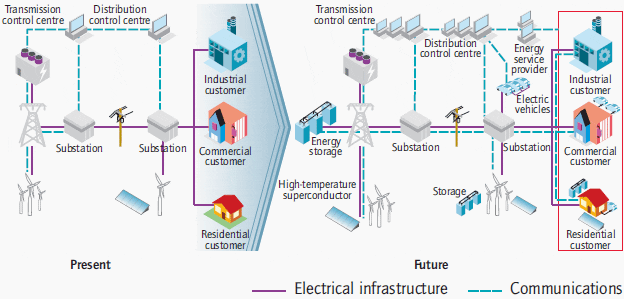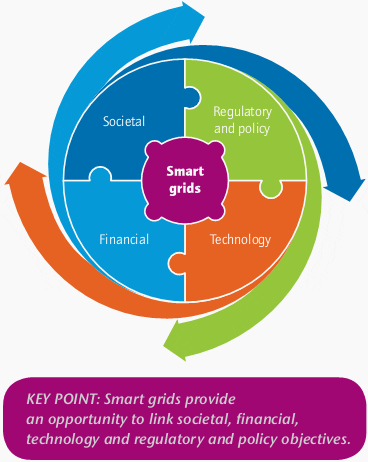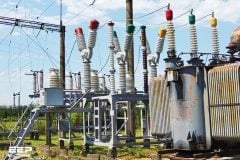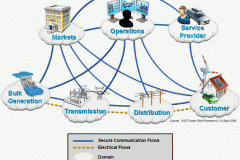
A smart grid is an electricity network that uses digital and other advanced technologies to monitor and manage the transport of electricity from all generation sources to meet the varying electricity demands of end-users. Smart grids co-ordinate the needs and capabilities of all generators, grid operators, end-users and electricity market stakeholders to operate all parts of the system as efficiently as possible, minimising costs and environmental impacts while maximising system reliability, resilience and stability.
For the purposes of this roadmap, smart grids include electricity networks (transmission and distribution systems) and interfaces with generation, storage and end-users.
While many regions have already begun to “smarten” their electricity system, all regions will require significant additional investment and planning to achieve a smarter grid. Smart grids are an evolving set of technologies that will be deployed at different rates in a variety of settings around the world, depending on local commercial attractiveness, compatibility with existing technologies, regulatory developments and investment frameworks.
Rationale for smart grid technology
The world’s electricity systems face a number of challenges, including ageing infrastructure, continued growth in demand, the integration of increasing numbers of variable renewable energy sources and electric vehicles, the need to improve the security of supply and the need to lower carbon emissions.
Smart grid technologies offer ways not just to meet these challenges but also to develop a cleaner energy supply that is more energy efficient, more affordable and more sustainable.
These challenges must also be addressed with regard to each region’s unique technical, financial and commercial regulatory environment. Given the highly regulated nature of the electricity system, proponents of smart grids must ensure that they engage with all stakeholders, including equipment manufacturers, system operators, consumer advocates and consumers, to develop tailored technical, financial and regulatory solutions that enable the potential of smart grids (Figure 2).

Smart Grid Characteristics
The main characteristics of smart grids are explained below:
Enables informed participation by customers
Consumers help balance supply and demand, and ensure reliability by modifying the way they use and purchase electricity. These modifications come as a result of consumers having choices that motivate different purchasing patterns and behaviour. These choices involve new technologies, new information about their electricity use, and new forms of electricity pricing and incentives.
Accommodates all generation and storage options
A smart grid accommodates not only large, centralised power plants, but also the growing array of customer-sited distributed energy resources. Integration of these resources – including renewables, small-scale combined heat and power, and energy storage – will increase rapidly all along the value chain, from suppliers to marketers to customers.
Enables new products, services and market
Correctly designed and operated markets efficiently create an opportunity for consumers to choose among competing services. Some of the independent grid variables that must be explicitly managed are energy, capacity, location, time, rate of change and quality. Markets can play a major role in the management of these variables. Regulators, owners/operators and consumers need the flexibility to modify the rules of business to suit operating and market conditions
Provides the power quality for the range of needs
Not all commercial enterprises, and certainly not all residential customers, need the same quality of power. A smart grid supplies varying grades (and prices) of power. The cost of premium power-quality features can be included in the electrical service contract. Advanced control methods monitor essential components, enabling rapid diagnosis and solutions to events that impact power quality, such as lightning, switching surges, line faults and harmonic sources.
Optimises asset utilisation and operating efficiency
A smart grid applies the latest technologies to optimise the use of its assets. For example, optimised capacity can be attainable with dynamic ratings, which allow assets to be used at greater loads by continuously sensing and rating their capacities. Maintenance efficiency can be optimised with condition-based maintenance, which signals the need for equipment maintenance at precisely the right time.
System-control devices can be adjusted to reduce losses and eliminate congestion. Operating efficiency increases when selecting the least-cost energy-delivery system available through these types of system-control devices.
Provides resiliency to disturbances, attacks and natural disasters
Resiliency refers to the ability of a system to react to unexpected events by isolating problematic elements while the rest of the system is restored to normal operation. These self-healing actions result in reduced interruption of service to consumers and help service providers better manage the delivery infrastructure.











please send me the pdf file
thank you
Great
Godd job done, informative for every engineer
Dear Edvard ,
great jobs sir .
thats really help us to solve our problems in field.
keep it up .
Regards,
Antonius Dicky
PT BDR INDONESIA